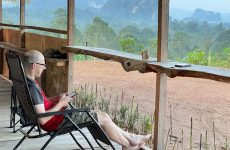Discover three major traditional architecture of Bidayuh people, the second largest tribe in Sarawak, Borneo. Longhouses are familiar among the indigenous people of Sarawak but the uniqueness of the architecture makes each tribe special. But wait, there is more than just a longhouse.
1. Bidayuh Longhouse is among the smallest longhouse compared to other tribes in Sarawak
The structure of the longhouse of the Bidayuh tribe takes the form of the rectangle that is much longer than the wide. Its size is usually expressed in the terms of its number of household apartments, or doors (a door representing one section). Compared to other tribes in Sarawak, the Bidayuh Longhouse is the smallest. Some Bidayuh longhouses in the mountain villages consisted of only a few apartments, each only a few meters wide and deep, and with a narrow gallery. This could be due to the terrain of the mountain that makes it difficult for building longer longhouse.
Among the Bidayuh, the village and the longhouse are seldom if ever the same.
In many other places, longhouses are large enough to contain entire village. Only few longhouses left nowadays due to modernization. There are more and more individuals wanting to have better individual houses.
Centuries ago, the traditional longhouse structures were tied with rattan, woody vines or creeper fibers and roofed with sago leaves. As time went by, renovations were carried out, resulting in some changes to the materials, especially for the roofs. This is due to the fact that sago leaves can only last for five to six years. As they are considered not long-lasting, constant maintenance is necessary after their lifespan. Nowadays, metal roofing materials – zinc and aluminium – are occasionally used for repairs.
Read more: http://www.theborneopost.com/2014/05/25/not-all-lost-to-modernisation/#ixzz4EAFiklV0
Most of the longhouse have their main pillars made of belian wood. Having belian pillars make the whole structure remained strong till today – and can be expected to last hundreds of years more.
2. Ceremonial House
The Bidayuh Baruk or Panggah is a ceremonial house used to be found in all Bidayuh villages. Some demolishing it upon their acceptance of the Christian faith. Rituals and cultural performances are held in this communal house and in the past headhunting days, head trophies were kept inside. Meetings were held here to discuss seasonal farm work or other affair affecting the whole community. Today, the Baruk still hold cultural value and remembered during Harvest Festival on every 1st June.
Features and History of Ceremonial House
The structure of this house is circular. It is about 3 to 5 meters above ground. The Bidayuh warriors would sleep inside the Baruk at nights to keep a watch for invading enemies. It was built in such a way to keep the enemies out where once the enemies were sighted, the 5 foot tall drum would be sounded, families are then rushed inside the Baruk and the shutters and doors of the tower would be closed. It would be quite impossible for the enemies to get into the Baruk giving the Bidayuh warriors a upper hand on attacking the enemies from up above and protecting the families.
3. Bamboo Bridges
Built using one of the toughest and abundant material found in the jungles of Sarawak, the bamboo bridge is used to provide walk ways over terrains ranging from muddy swamps to cliffs with rushing water. It is typically built using matured bamboo and replaced on a yearly basis.
Suspension Bamboo Bridges
There are also suspension bamboo bridges made by the locals. The bridges (right photo above) seems to float across the river with so little visible support. Those bridges are now drowned by dam water as the water is filling up the dam area at Bengoh valley.
Here is how the bridges was built. First, a site with sturdy trees on both banks was chosen. After that, a long bamboo was tied to one tree with steel cables or ropes and connected to more bamboos anchored to the ground. At the end of the bamboo’s length, another bamboo will be tied upon it and the process continued until it reached the other bank. The bridges was rebuilt twice a year, before Gawai (the Harvest Festival) and Christmas. It takes about 20 men to finish a bridge in one day.



